Abstract
As a significant stratum of film audiences, adolescents are often more susceptible to influence by film characters. Motivated by the question of what types of role models are presented to Iranian adolescents via the medium of cinema, we aim to study Narges Abyar’s 2013 film Track 143 (Shiyar 143 2013) to figure out how the rhetorical mechanisms of the film persuade adolescent audiences to identify with the protagonist and imitate the positive aspects of the main character as their role model. To this end, we draw on the visual rhetorical method as our analytical framework and employ Albert Bandura’s notion of observational learning to interpret the data. We hope to identify the rhetorical techniques employed effectively in Track 143 for persuading adolescent girls to follow a female protagonist of their own choosing as their role model. According to our findings, the film does not rely on logos or discursive reasoning. In this sense, the female protagonist overcomes her problems not through her own personal characteristics, which could have been taken up by female adolescent audiences, but through merely random and miraculous incidents.
Keywords: Female adolescents, Rhetorical analysis, Observational learning, Iranian cinema.
The use of the term rhetoric goes back to ancient Greek philosophy. For a long time, following Quintilian’s definition, rhetoric was used to denote the art of ‘speaking well’ (Logie 2003). It was Aristotle, however, whose definition of rhetoric as ‘the faculty of observing in any given case the available means of persuasion’ informs our contemporary usage of the term (Aristotle & Roberts 1994, B. 1, C. 2, S. 1359). To Aristotle, rhetoric is synonymous with oratory or the art of persuading an audience (Ahmadi & Pournamdarian 2017). Gradually, the term went beyond its early function of persuading an audience and was employed in literary criticism (Ahmadi, 2015) to denote any use of signs for persuasion purposes. Such a generic definition equates rhetoric with communication. As communication scholars moved away from the classical notion of communication as a top-down persuasive process toward a horizontal and two-sided phenomenon, Copiers (2009, quoted in Montazerghaem & Yadegari 2016) set a milestone in the evolution of communication by redefining rhetoric as the strategy of using communication (whether in oral or in written form) for ‘specific purposes’.
Copiers’ conception of rhetoric generalizes the notion of artifact, which used to be limited to words and sayings in traditional rhetorical criticism, to other types of texts, i.e., visual texts, as well. The shift from speech to text and then to image evokes the same trajectory taken by semiotics and discourse analysis. Ahmadi (2018) discusses three eras in the history of rhetoric, namely, the era of sermons, the era of written texts, and the third or modern era, where rhetoric related to the domain of images. This threefold division is in line with Mitchell’s discussion in Picture Theory (1994) of Rorty’s three historical turns. Rorty identifies three turns in the history of philosophy. Whereas Ancient Greek and medieval philosophy relied on things, 17th to 19th century philosophy relied on ideas, the philosophy of the enlightenment era relied on words for its specific emphasis on rationality. Mitchell, however, adds a fourth turn, the ‘pictorial turn’ and claims that this new turn organizes a new way of thinking around images.
The foregrounding of the image in modern and postmodern times, termed as visual centrality by Martin Jay (quoted in Rose 2002), highlights the necessity of a media studies approach to cinema. Today, the visual media disseminate knowledge; in this sense, understanding is essentially tied to vision/seeing. The foregrounding of the image in disseminating knowledge is precisely what marks the necessity of analyzing films rhetorically, from a communication perspective. Most academic studies of cinematic productions, whether by art scholars or communications scholars, are limited to film analysis, thus, failing to consider cinema as a medium. In other words, current film research contributes primarily to cinema studies rather than to communication studies as a subfield of social science. Rhetorical analysis overcomes this limitation effectively as it relates to the communicator/rhetor on the one hand and to the audience on the other hand.
In visual rhetorical analysis, the researcher seeks to understand the rhetorical mechanism by which the artifact of the image affects the audience. And it is the objective of rhetorical criticism to identify such rhetorical techniques, evaluate their effectiveness, and offer a strategy to optimize communication in terms of effect and purpose (Foss 2004).
Obviously, the aim of the present study is not to discuss, for instance, how women are represented in cinematic productions, but to study and speculate about the possible role of more female-centered films in influencing female audiences and disseminating knowledge to them, which may well lead to improved well-being in women. Importantly, personal strengths contribute to well-being, and film is a rich source for building such points of strength (Jones 2014). In a word, cinema can, at least to some degree, ensure the well-being of its audiences by highlighting personas with positive personality traits.
As a significant stratum of film audiences, adolescents are often more susceptible to influence by film characters. In this sense, film characters or actors may serve as role models for adolescents and shape their yet-evolving personalities. Bandura believes that one way for children and adolescents to learn is following others (parents, teachers, peers, film characters) as their role models (quoted in Jones 2014). Research has shown that female Iranian adolescents do not have any female role models (Soltanian 2016). This finding points to the failure of our media productions in representing women and setting female role models.
In this light, the present study seeks to investigate the rhetorical mechanisms of Narges Abyar’s Track 143 – as a film with a female protagonist – in setting a female role model. In what follows, we will analyze the film from a rhetorical perspective and interpret it through Bandura’s theory of observational learning. In this study, we aim to identify the persuasive mechanisms by which the film represents the main female character as a role model for its audiences (especially female teenagers) and discuss the possible techniques that could be used to achieve this objective in a more effective way.
Research Background
In this section, we will review two streams of prior research: 1) studies that address role-model adoption in female Iranian adolescents and the part that the media plays in that regard, and 2) studies that owe their method to rhetorical film analysis.
Pouryousefi et al. (2009) conducted a study to identify the factors affecting female secondary school students’ adoption of role models for social behavior. By considering factors such as the parents’ level of education, social status, school education programs, mass media, peer and reference groups, and proclivity to fashion and unity as the independent variables and the learning of social behavior through role models – that is, socialization – in female students as the dependent variable, they tried to evaluate the effects of each of the abovementioned factors on adolescent girls’ socialization through the adoption of role models. For the research, they relied on literature review and surveys to find out that there was a significant relationship between the dependent variable (socialization or the learning of social behavior through role models) and the following independent variables – the parents’ level of education, social status, school education programs, and peer groups. However, contrary to other researchers stating that the media affect adolescents’ and young people’s adoption of role models for social behavior, Pouryousefi et al. found no significant relationship between the two factors.
In contrast, the results of a survey by Roshandel Arbatani and Amiri (2010) on media consumption patterns and the degree of receptiveness to media among 600 high school students in Tehran revealed that students are most highly susceptible to influence from TV, followed by computer games as the second most important influential medium. Given the high level of susceptibility to influence from TV, they also suggested that this medium can be effectively used to shape adolescents’ behaviors by presenting appropriate behavioral patterns and educational messages. It must be noted, however, that the main objective of this study was training students on law enforcement.
In another study, Aghajan Beglou et al. (2013) examined the relationship between visual media and rural young girls’ selection of role models. In this survey, 351 rural girls living in Bushehr province, Iran, were selected through cluster sampling. Based on the hypothesis that the media serve as modern reference groups and influence young people’s modern social patterns, the researchers found out that visual media, especially satellite TV, had a decisive role in young girls’ selection of role models. Most of the participants showed a tendency to adjust their looks, homes and even their standards of marriage to what they would see in TV series and films.
Above all, in a thesis paper that serves as the point of departure for our study, Soltanian (2016) identified and reported the most influential social role models among female students in eastern Tehran. Among them were, in order of importance, Ehsan Alikhani (TV presenter), Mostafa Zamani (actor), Pouria Poursorkh (actor), Shahab Hosseini (actor), Armin 2AFM (singer) and Justin Bieber (singer). Interestingly, none of the role models were female. The role modes’ careers, as mentioned above, highlights the fact that teenage girls rely on the media for role model selection.
Yadegari (2015), in his thesis paper, conducted a rhetorical analysis on two political documentary films, According to the [Royal] Court (2015, Be Revayat-e Darbar) which was broadcasted by IRIB, and Iran and the West (2009) by BBC. Yadegari employed five key indices for rhetorical analysis including narrative, honesty, objectivity and evidence, trust and credibility, and emotional motivation. Each of these indices encompasses several other subcomponents in its own turn. Narrative, for instance, overarches characters, narrator, narrative twists, conflicts and tensions, opening, ending, setting, assumptions, causality and causal relations, point of view, honesty, accuracy, integrity, style and expression. In addition to rhetorical analysis, the researcher also employed in-depth interviews to survey 24 male and female graduate students of communication and media, political science, cinema, and history. The researcher identified and evaluated the following extra-textual factors as effective in persuasion: genre, discourse of the producer media, novelty in form, novelty in content, and political and historical consciousness of the audience. Given the mixed method of using rhetorical analysis and in-depth interviews, this research provides a holistic view of the content and its interaction with the audience. However, the indices were not tested before and were not extracted directly from interviews or pre-tests. The five above-mentioned indices and their subcomponents were established independently by the author, with no reference to other possible applications of the same indices and subcomponents in other studies.
Montazer-Ghaem and Erfani-Hosseinpour (2014) provided a framework for the analysis of environmental documentary films. They considered five categories: characters, the rhetoric of human error and determining the blameworthy person, emotional appeal and motivations, logical persuasion techniques, and sustainable development. Each category included several subcomponents. For instance, the category of characters was reported to be made up of local witnesses, experts, authorities and narrators.
In addition to these five categories and their subcomponents, the researchers also borrowed Schwartz’s model of communication in the age of electronic media, which studies media contents in three branches: verbal script, visual script, and audio script. The researchers analyzed Ağlar Gül (2010), a documentary film by Behrooz Alemi, in terms of the three scripts mentioned above, and compared them with their own suggested categories. After an introductory note on the film and how it was produced, Montazer-Ghaem and Erfani-Hosseinpour explain the rhetorical context of the film by providing a description of the social and historical position of Lake Urmia at the time of production, a description of the narrative, and a report on the rhetoric of the documentary. As in previous studies, they do not provide any explanation on the reasons or procedures for selecting the five suggested categories. They take into account the auditory and visual codes of the work, however. This highlights the fact that film as a medium is not limited to dialogues and a story, but rather, it also uses visual elements insofar as the medium of film is basically visual. Whereas an exclusive attention to the story comes at the price of neglecting the other elements of the film, the visual codes in particular, a more comprehensive approach to film, one that considers its multiple semantic layers and discursive modalities, goes beyond the mere analysis of the plot insofar as film is essentially different from other media such as novels and film scripts.
Theoretical Framework
In his many works, Albert Bandura develops the concept of observational learning within the larger framework of cognitive social theory. It is with this concept that Bandura reveals his sensitivity to the role of communication and the media in the learning process. Alongside the notions of reinforcement, memorization and retention, the question of role model adoption or imitation lies at the heart of the learning process. To clarify this further, we will present a brief overview of Bandura’s concept of observational learning.
The notion that all human behavior is shaped by trial and error and by personal experience seems to be too limited and far from the truth; we can learn the likely result(s) of a certain act by looking at others. Bandura believes that most of our behaviors are inspired by role models or examples. Sometimes this is intentional, and other times unintentional. According to Bandura, role models play a key part in learning. The other functions of role model adoption are facilitating and reinforcing behaviors.
If TV representations are so effective, it is because people’s social construction of reality relies heavily on what they see, listen to and read rather than on what they experience directly. Modeling influences serve diverse functions in promoting personal and social change (Bandura, 2002). “They include instructive, motivational, social promoting and social construction functions. With regard to the instructive function, models serve as transmitters of knowledge, values, cognitive skills, and new styles of behavior… Observers learn to fear that which frightened or injured models, to dislike what repulsed them, and to like what gratified them. Self-debilitating fears and inhibitions can be eliminated by modeling that depicts effective coping strategies and instills a sense of coping efficacy” (Bandura 2004,78).
Three types of model adoption are used in the entertainment-educational approach: positive, negative, and transitional. To take advantage of the value of associating attractiveness, appeal and credibility in model adoption, culturally acclaimed TV role models were selected to represent useful behavioral styles. It is worth noting that social attention enhances the effects of model adoption.
By witnessing characters change their lives, people also take up strategies to figure out how to succeed. In addition, role models presented in TV programs improve the audiences’ sense of achievement, the feeling that they too can succeed. Viewers admire the characters with whom they sympathize and rely on them for inspiration when it comes to tackling and overcoming difficult situations.
A series, for instance, can feature positive models who depict useful lifestyles and/or negative characters who represent harmful attitudes. Transitional models change their lives by moving away from uncertainty or by discarding harmful behaviors in favor of more useful behaviors and lifestyles. In particular, viewers are inspired by and sympathize with transitional models as they watch them do away with harmful habits.
Observational learning has four stages:
Attentional Processes:
Mere exposure to a model does not guarantee that one learns and performs the behavior exhibited by the model. Features that are more familiar and more understandable to the viewer will be selected and imitated sooner. In addition, the model’s appeal is another feature that influences the learning process. Some models are so attractive that they attract people of all ages. Role models introduced through the media (especially TV) are good examples.
Retention Processes:
Unless a person incorporates the behavioral characteristics of a model into his or her memory, he or she cannot learn anything from the model. In fact, observational learning requires some form of long-term memory.
Motoric Reproduction Processes:
The likelihood that a certain behavior is reproduced and mimicked depends on whether the imitator has the openness and skills needed to reproduce the observed behavior.
Reinforcement and Motivational Processes:
Even if a person can learn and remember a behavior, if the learning process is associated with a negative atmosphere, the learning will not be operational. According to Bandura, when positive incentives are presented in an observational learning process that has remained in the observation stage, the learning process will quickly move onto the stage of action (Bandura 1971).
In order to identify some of the positive personality traits and strengths for subsequent evaluation of the models, we have used the Values in Action (VIA) Classification.
Personality Strengths according to the VIA Classification:
Virtue I. Wisdom and knowledge: Creativity, Curiosity, Open-mindedness, Love of learning, Perspective
Virtue II. Courage: Bravery, Perseverance, Honesty, Zest
Virtue III. Humanity: Love, Kindness, Social intelligence
Virtue IV. Justice: Teamwork, Fairness, Leadership
Virtue V. Temperance: Forgiveness, Modesty, Prudence, Self-regulation
Virtue VI. Transcendence: Appreciation of beauty and excellence, Gratitude, Hope, Humor, Religiousness (Ruch et al 2011)
Methods and Procedures:
Cinema always offers a fragmented and selective image of reality. And the reality that it represents is not objective but objectivized since it is always framing. The filmmaker, through the infinite possibilities of representing reality, organizes the frame of his or her work in a special way. Framing involves choosing aspects of reality and foregrounding them in the context of communication. It stakes a claim to affecting people’s perceptions, i.e., to constructing reality (Mehdizadeh 2014). Social constructionism is influenced by continental hermeneutics. In the European tradition, hermeneutics is the original paradigm of exegetical tradition (Lindlof & Taylor 1995). Every reading of a text is a self-specific interpretation. In this sense, the reading of a film is also subjective because what we are dealing with here is not reality itself but an image of reality, an image that refers to a pre-existing reality by means of signs. One component of any sign is the signified which is evoked in the mind. Therefore, subjective epistemology and interpretivist methodology lead researchers to a qualitative method.
Chandler (2015) considers rhetorical analysis – alongside semiotics, discourse analysis, and content analysis – as one of the methods of textual analysis. On the one hand, the method of visual rhetorical criticism depends much on semiotics as a method of studying the use of signs and their meanings (Foss 2004), and it relies heavily on the tripartite categorization of signs (iconic, indexical, symbolic) (Lester 2018). On the other hand, traditional rhetorical analysis, which we have used in this study, highly correlates with the concept of discourse. Therefore, it can be concluded that the method of visual rhetorical criticism used for film analysis can be one of the most comprehensive methods of text analysis as employed in this study.
Foss (2004) also states that researchers in rhetoric focus on three domains. They focus first on the nature of the artifact. To this end, they identify the elements of the text under analysis (shape, color, medium). Every other step in rhetorical analysis depends on this initial stage. In the same vein, Wetherbee (1) argues that the rhetorical criticism of film does not regard film as a fixed text; rather, the film is an audiovisual tone that is embedded within a larger discourse and connects smaller fragments of expression to create an attitude in the audience.
Considering the closeness of visual rhetorical criticism and semiotics, we have used the concept of ‘The Rhetoric of the Image’ proposed by Roland Barthes the semiotician (1977; quoted in Sojoudi 2014) in his article of the same name as well as Keith Selby and Ron Cowdery’s table on semiotics.
| Signifier | Signified | |
|---|---|---|
| Shot size | Big close-up Close up Medium-shot Long shot |
Emotion, a vital moment, drama Intimacy A personal relation to the subject Context, public distance |
| Camera angle | High Eye-level Low |
Domination, power, authority Equality Weakness, powerlessness |
| Lens type | Wide angle Normal Telephoto |
Dramatic Everydayness, normality Voyeurism |
| Composition | Symmetrical Asymmetrical Static Dynamic |
Posed, calm, religiosity Natural everyday Lack of conflict Disturbance, disorientation |
| Focus | Selective focus Soft focus Deep focus |
Draws the attention - ‘look at this’ Romance, nostalgia All elements are important - ‘look at everything’ |
| Lighting |
High key Low key High contrast Low contrast |
Happiness Somber Theatrical, dramatic Realistic, documentary |
| Film stock | Grainy Smooth ‘fine’ grain |
Documentary realism, authenticity Natural everydayness |
| Color | Warm (yellow, orange, red, brown) Cool (blue, green, purple, grey) Black and white |
Optimism, passion, agitation Pessimism, calmness, reason Realism, fact, actuality. |
| Cinematic codes | Zoom in Zoom out Pan (left or right) Tilt (up or down) Fade in Fade out Dissolve Wipe Iris out Cut |
Observation Context Survey, follow Survey, follow Beginning Ending Passage of time, a link between scenes An imposed conclusion Old movies Simultaneity of time, attention |
Table 1: Source: Selby and Cowdery (1995, 57-58)
Let us turn now back to the three areas of rhetorical criticism proposed by Foss (2004). The second area of focus for researchers in rhetoric is the function of the artifact. An artifact is meant to evoke feelings of empathy, sadness and happiness or invite the audience to understand their personal inhibitions. It is important here to not confuse the function of the artifact with the intention of the rhetor. In rhetorical studies, it is believed that an artifact operates independently of its author’s original intention. And the last area of focus in rhetorical analysis is the evaluation of the artifact. At this stage, the first two areas are combined: The critic assesses whether the elements used in the artifact have been capable of fulfilling the expected and apparent function or not.
The column of the signifier in Selby and Cowdery’s table corresponds to the first stage while the column of the signified points to the expected function. However, evaluating the success of the film’s artifact in employing rhetorical tools is done by integrating the theoretical framework used in the research and the three tools of traditional rhetoric, that is, Aristotelian rhetoric.
In his Rhetoric, Aristotle determines that persuasion comprises a combination of three appeals under artistic or technical arguments – arguments that are established by the rhetor, just as in the case of Track 143’s director (Ahmadi 2018): ‘ethos’ (which presents the rhetor’s apparent moral standing in the eye of the audience), ‘pathos’ (which taps an argument’s emotional aspect) and ‘logos’ (which comprises the facts or arguments used to persuade the audience) (Ross 2014).
Let us look again at the connection between discourse, the rhetor and more contemporary uses of ethos. According to Martha S. Cheng (2008), ‘the concept of ethos, traditionally taken from Aristotle’s Rhetoric and referring to the role of the rhetor’s character in a speech, has typically been deployed in studies of planned, formal texts. However, modern investigations of ethos emphasize the interactive nature of ethos formation – interaction among the rhetor’s social roles and prior reputation, the discourse, and the audience’s expectations. […] Modern developments in theories of ethos correspond with major areas of narrative theory, [… hence, the emphasis] on the use of narratives in ethos formation’ (195).
Bearing in mind the principle that genre is essentially designed to have a rhetorical effect (Wetherbee 2011), we decided to conduct a purposive sampling to limit the options among Iranian melodramas. We chose melodramas since they usually revolve around a female protagonist and conveniently appeal to female audiences (Grant 2011). Finally, we came up with Track 143 and decided to analyze the film on a sequence-by-sequence basis, since it would have been impossible to analyze a 90-minute film frame by frame and it would have reduced the precision if we had chosen a greater unit of analysis. Clearly, a semiotic analysis of all the elements and codes of a sequence in a research project would not be scientific or helpful whatsoever. To overcome this dilemma, one can easily refer to the concept of ‘markedness’ in the Prague linguistic circle. The unmarked form is a recurring, neutral and ordinary event (Lorenzo-Dus 2011) which fails to provide a rhetorical analysis of a text. Analyzing the front cover of Paris Match in his essay ‘Myth Today’, along the lines of ‘The Rhetoric of the Image,’ Barthes suggests that myth tends to naturalize/normalize things and to disguise itself as the explicit meaning of the sign (Sojoudi 2014). In this light, we attempt to study only marked elements in our analysis of Track 143.
Rhetorical Analysis of Track 143
Olfat, a lively and hard-working widow, looks after her two children, a daughter and a son named Yunos, by herself. When he is 19, Yunos decides to leave school and signs himself up to go to the front in the Iran-Iraq war. During an operation in 1982, he disappears and is reported missing in action. Over the years, Olfat keeps hoping that they find his body or maybe alive in captivity. Eventually, a soldier discovers where Yunos’ bones are buried. He meets Yunos in a dream that recurs for two nights, telling him to look for his body in a war zone called Track 143. Olfat reunites with what is left of her son and settles down after years.
First, following Selby and Cowdery’s table and Barthes’ method, we will provide a rhetorical analysis of a series of marked scenes from Track 143, which can represent features of a whole sequence or the entire film. Then, we will look at each of the three appeals known as ethos, pathos and logos along with other codes.
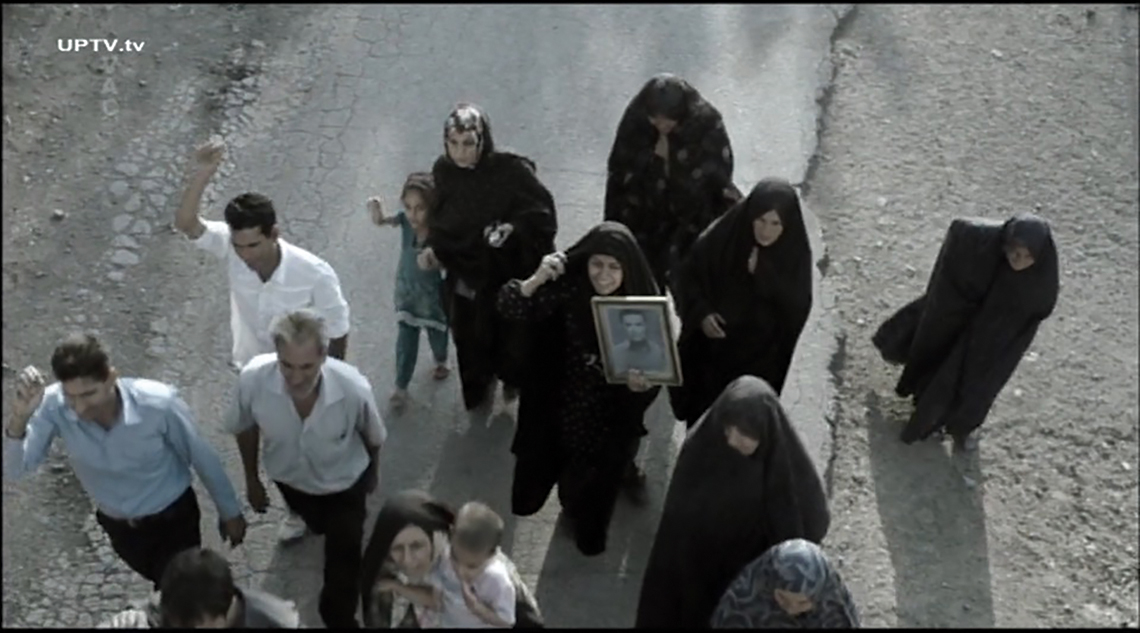
Image 1
In this frame, the camera angle produces a high-angle shot. Olfat is standing right in the middle of a crowd. She is finally left alone as the crowd passes by her, and the camera angle highlights her weakness and inability. This view and the larger sequence to which it belongs, where Olfat inquiries about her son, deploy the appeal of pathos. We see a hard-working woman who fails to reach her goals no matter how hard she tries, just like she cannot finish the carpet she keeps on making. Her inability despite all the efforts that she makes provokes the emotions of the audience.
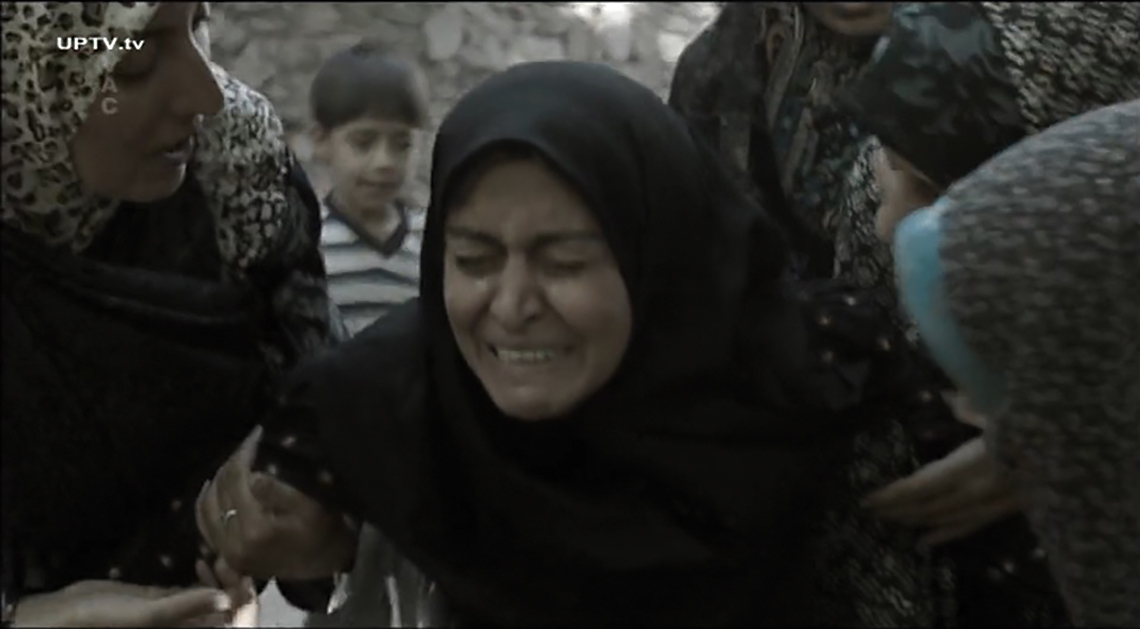
Image 2
Olfat affects both the viewers and the women who surround her in that their emotions are provoked by pathos alike. The use of the medium-shot here is intended to create a sense of closeness in the audience toward the character. Olfat’s touching expression as she breaks into tears points to the filmmaker’s deployment of Aristotelian pathos – as the strongest and most immediate human drive.
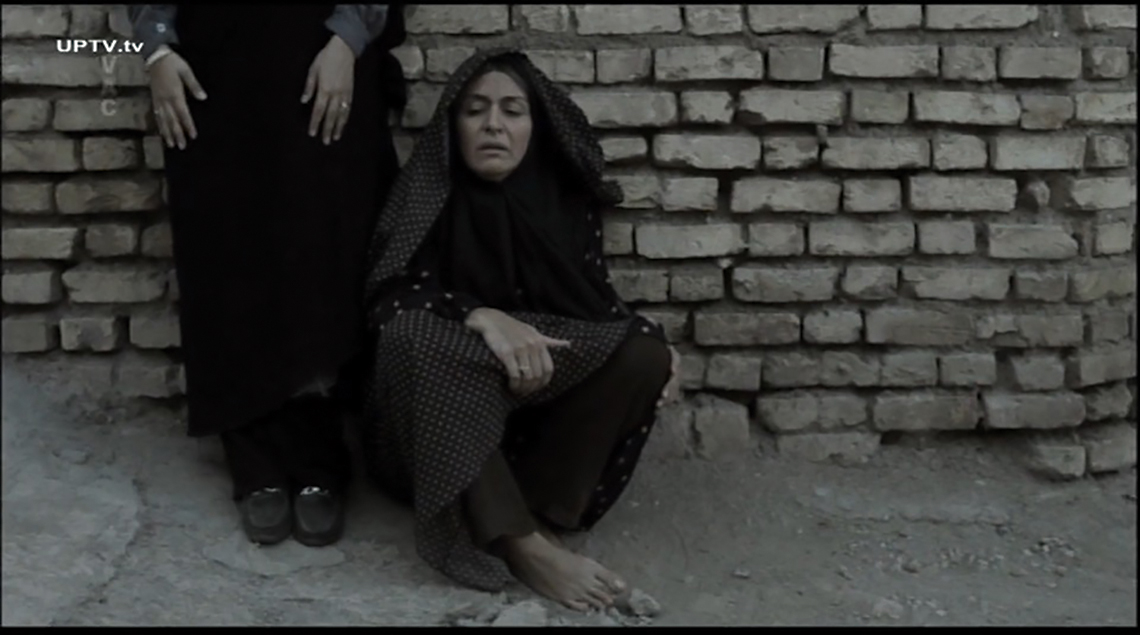
Image 3
In this shot, we are still faced with pathos, with the image of a helpless woman sitting on the ground. The composition is asymmetrical, pointing to Olfat’s everyday life on an endless loop between helplessness and frustration.
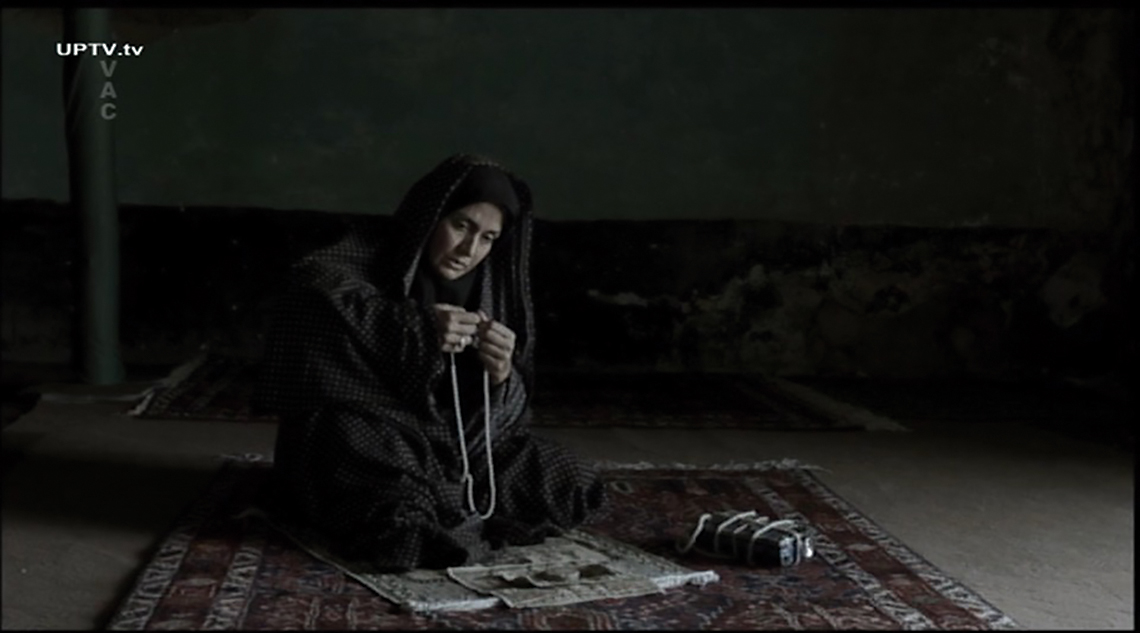
Image 4
In this shot, the rhetorical technique of ethos is more pronounced, where the speaker/rhetor attempts to associate the character with such attributes as wisdom, morality and reliability and a sense of calm and moderation that perfectly fits the symmetrical composition. However, lighting is still low key, which resonates with sadness. Here again, as in the previous sequences, pathos is present.

Image 5
The filmmaker uses a lot of paralleling/mirroring. The carpet is a parallel of Olfat’s restless soul; the radio is a parallel of Yunos; and in this shot, the explosion at the engineering site, as Olfat is watching, serves as a metaphor for her spiritual turbulence. A carpet that Olfat cannot finish until she finds peace, a radio that she does not put down until Yunos’ body is found, and an explosion that functions as the extension of her psyche, all, accentuate Olfat’s emotions and those of ours. This is nothing but pathos.
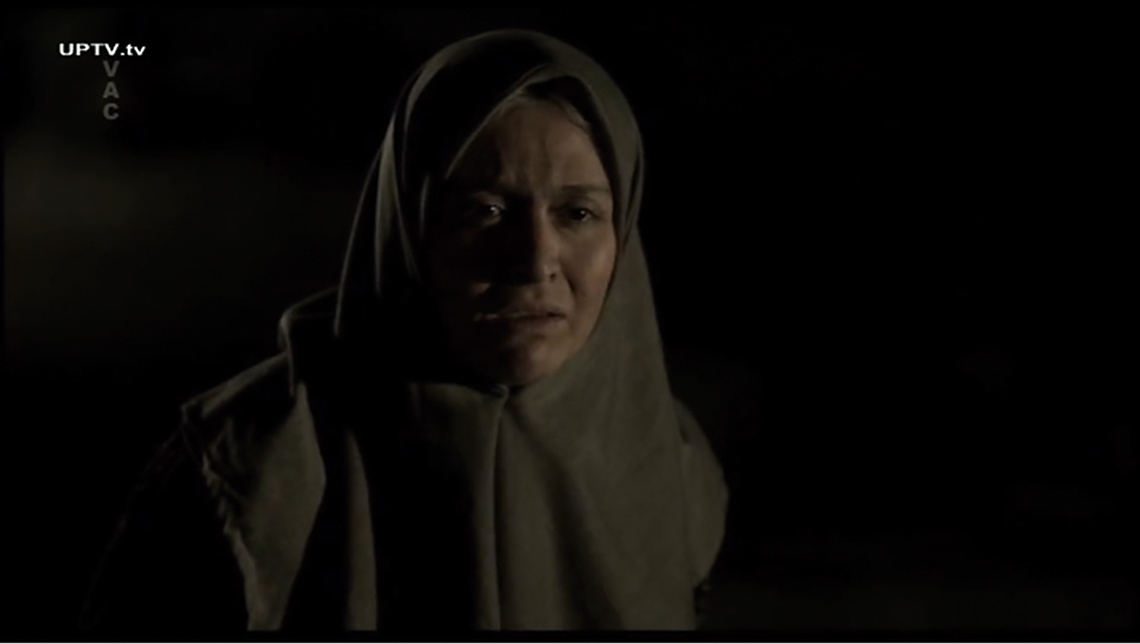
Image 6
Throughout the film, even in exterior and daylight shots, lighting is low key to convey a sense of sadness, and colors are cool or tend toward black and white to evoke sometime in the past and create an atmosphere of cynicism and despair in the film. The appeal of pathos manifests itself most markedly with respect to lighting and shot size throughout the film.
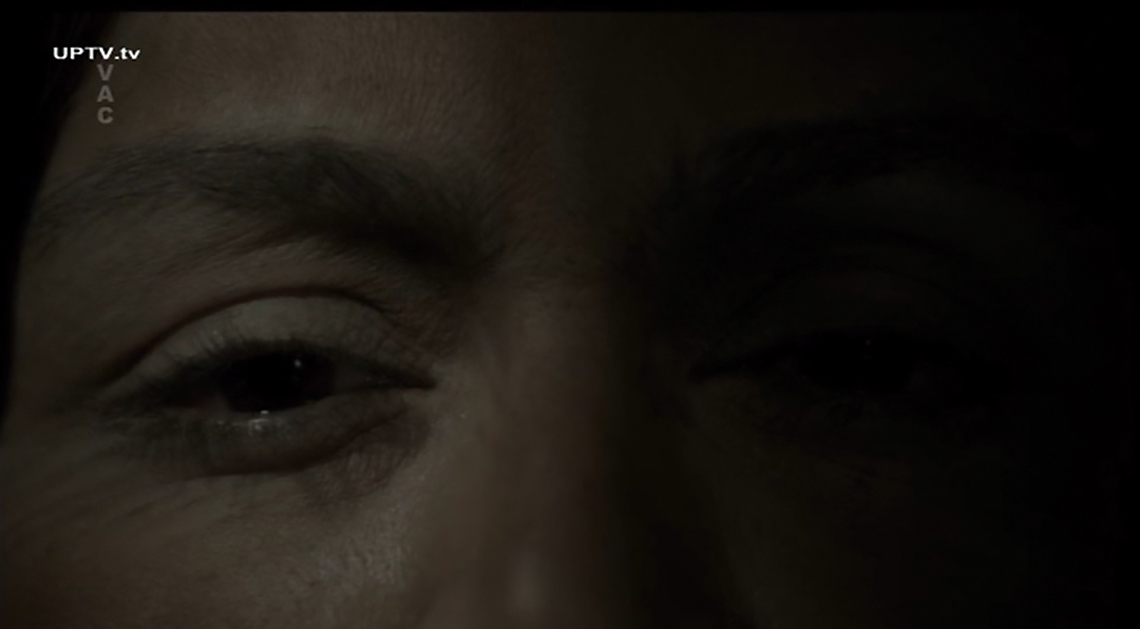
Image 7
The signified of the big close-up is ‘emotion, a vital moment, drama’. Throughout the film, there is no big close-up except this one shot, which thanks to the lighting and shadow play conveys Olfat’s state of being in-between, half hopeful and half hopeless, half in turmoil and half in peace. With pathos, the rhetor uses aesthetic elements to convince the audience through an appeal to emotion.
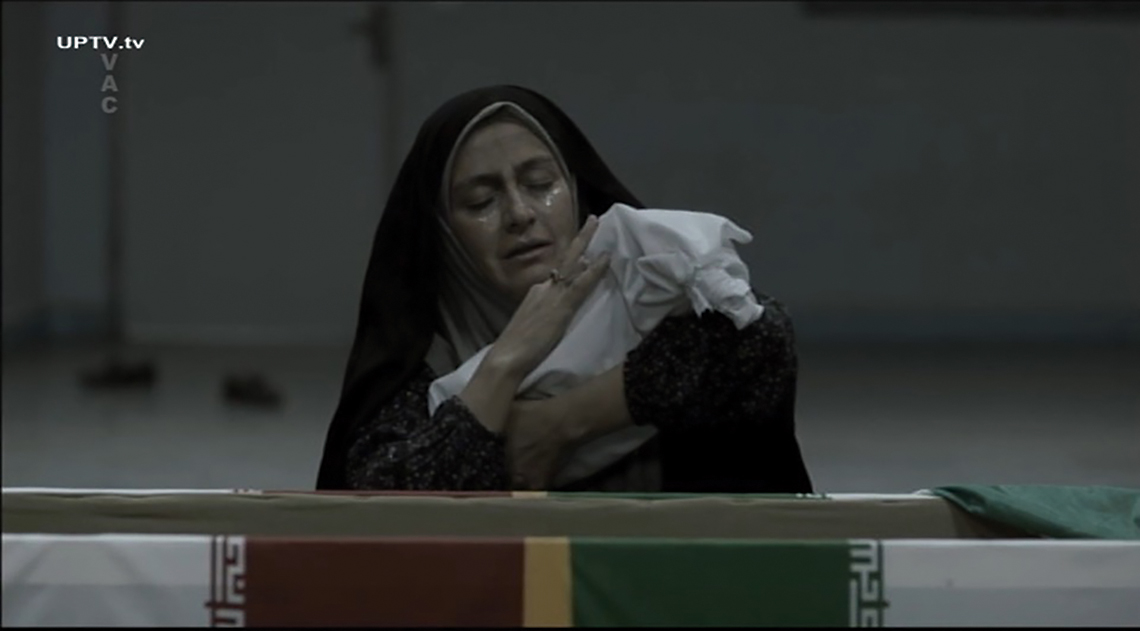
Image 8
The flag of Iran in this shot represents patriotism. The juxtaposition of the flag and the figure of the mother evokes the archetypal notion of motherland – mother and homeland, two archetypes, in one shot. Olfat’s shoes are left at the door in the depth of the shot as a gesture of respect for her martyred son and the flag that represents homeland. The composition is completely symmetrical, pointing to a sense of calm and spirituality. Closed eyes remind the tranquility of a sleeping person. And the tears of the mother appeal to the emotions of the audience by reference to motherhood and maternal instinct; once again, pathos. However, there are signs of ethos too, with tranquility and moderation being the first signs.
Ethos:
In order to tie the character to the moral beliefs of the audience, the rhetor uses the appeal of ethos (Roskelly 2008). Olfat is presented as a religious and moral person. She goes to her son’s workplace every day, cooks for him, brings food for his coworkers in votive obligation, and is close to children more than any other character in the film. We always see her busy working, never at rest. She avoids talking behind anyone’s back, asks God for forgiveness, and never misses a prayer. She also says salawat as a habit and the film ends with that. There is a scene in which Olfat’s daughter says, “This sadness made Olfat a great person. When I sat next to her, I felt little.” These are all part of the rhetor’s efforts to build an ethical image of the heroine and get closer to the moral and value system of the audience so as to persuade them to sympathize with and imitate her. This is precisely the point of connection between ethos on the one hand and the ruling discourse and the value system that emerges from it on the other hand. Therefore, it is possible to trace many of the VIA features in Olfat. The values of courage, humanity and transcendence are all visible in her.
Pathos:
It is characteristic of melodrama as a genre to arouse emotions and feelings. That is why pathos is the dominant drive in the film. As already described in the discussion on visual rhetoric, the film’s visual and formal codes, such as lighting, color and composition, all serve pathos. Restless, crying, fragile body postures all depend on pathos.
Logos:
In this film, the least frequent use is made of the appeal of logos. Logos is accompanied by reasoning and argument. In the film, we find that Olfat does not believe in fortune-telling or amulets. However, we do not hear any rational arguments for such disbelief on her part. At the same time, she is superstitious and she does not provide rational arguments for her actions and feelings either. She is afraid of foxes making sounds. And when she sees a tilting ladder, she anticipates that bad things might happen with no good reason. In the characterization of Yunos, however, there are references to logos. In a sequence that depicts his childhood, Yunos constantly asks existential and logical questions of her mother, but she cannot provide answers as she is not specially characterized by logos. Nevertheless, Yunos forgets his spirit of inquiry later and resorts to threats and intimidation, instead of dialogue and logic, to convince his mother. Other characters in the film also lack the drive of logos. Mashali Bemun, for instance, fails to offer a convincing argument in his desperate attempt to comfort Olfat. Basically, the film relies on supernatural explanations for its development. If Yunos did not meet the soldier in his sleep, if the soldier did not insist or, even earlier, had not let himself off the hook from exemption, the film could only reach this point in its development. The film’s plot is based not on logical causality but rather on chance, fate, and intuitive, irrational incidents.
Conclusion
In this study, we sought to identify the rhetorical techniques used by the rhetor/director of Track 143 to produce a convincing female protagonist and to effectively affect the audiences. The aim was to figure out if female teenagers, as a stratum of film audiences, were exposed to an appropriate female protagonist and if there were appropriate criteria for the presentation and characterization of female protagonists. In addition, we aimed to answer the question whether the film could succeed in presenting its female protagonist as a role model for female teenagers. To answer these questions, we conducted a rhetorical analysis of the film and found that Track 143 makes use of pathos more than any other form of appeal to arouse the emotions of its audiences, and this was quite predictable given the melodramatic genre of the film.
Ethos is directly connected to the discourse and ideology of the film. The results of the analysis indicate that the rhetor aims to associate the heroine with the ideology of patriotism and religious beliefs. In addition, with ethos, the rhetor aims to offer an acceptable appearance for the female protagonist. Therefore, according to the VIA table, Olfat is characterized by such positive features as courage, humanity, justice and temperance while she lacks the value of wisdom. This is another evidence for the claim that the rhetor does not use logos in characterizing Olfat.
In fact, Olfat and the rest of the film’s characters are rarely characterized by logos. However, media literacy studies indicate that today, audiences of audiovisual media have a generally higher level of media literacy than ever before. Contemporary audiences are less predisposed to emotionalism; instead, they tend to communicate with a critical approach and with logical analysis (Buckingham 2007). This means that using the appeal of logos can increase the persuasive force of the word – which is not the case in Track 143.
A look at the theoretical framework of the study brings us to the conclusion that Olfat is a positive and transitional model – positive because, from the beginning to the end, we face a personality with many VIA features, and transitional because, in Bandura’s words, many of these features expand throughout the film. The sense of tranquility and moderation characteristic of ethos becomes clearer in Olfat toward the end of the film. As noted by her daughter, Olfat grows up in sorrow and others are humbled by this. According to Bandura, as a protagonist overcomes a dilemma, viewers are encouraged to follow in his/her footsteps. However, Olfat does not find a way out of sadness. Only by miracle does she break free from suffering and hardships. A teenage girl watching this film will probably learn to deal with problems not by recourse to logos (logic and reasoning) but by wishing for miracles.
In the end, as already pointed out, Bandura describes four different stages for observational learning. The first process (attention) is met here as the model is mediated by an audiovisual, collective medium and can be potentially received by all age groups, including teenagers. The second and third processes (retention and production) are directly related to female teenagers as the film’s audience. However, the reinforcement and motivational process needs external reinforcement. This is where we wish to propose a suggestion for further research. Future researchers may refer to social factors that underlie and reinforce positive personality traits and patterns of behavior to figure out the extent to which the features acquired by teenagers from the media can determine their personality traits.
References
Aghajan Beglou, Soosan., Homeira Bazrafkan., and Ali Rouhani,. 2013, “Investigating the relationship between visual media and selection of lifestyle”. [Original in Persian,] [Iranian Journal of] Women and Society. 4(1): 141-164.
Ahmadi, Mohammad. 2015. “The nature of rhetorical criticism and its importance in literary criticism”. [Original in Persian,] [Iranian Journal of] Applied Rhetoric and Rhetorical Criticism. 1(1): 46-63.
Ahmadi, Mohammad., and Taqi Pournamdarian. 2017. “An introduction to the most important meanings of the term rhetoric”. [Original in Persian,] [Iranian Journal of] Studies in Language and Translation. 50(1): 27-52.
Ahmadi, Mohammad. 2018. Rhetoric: From theory to criticism. [Original in Persian,] Tehran: Institute for Research in Humanities and Cultural Studies.
Aristotle & Roberts, W. R. 1994. Rhetoric. Cambridge. MA: Internet Classics Archive.
Bandura, Albert. 1971. Social Learning Theory. New York: General Learning.
Bandura, Albert. 2002. “Growing primacy of human agency in adaptation and change in the electronic era”. European Psychologist. 7: 2-16.
Bandura, Albert. 2004. Social Cognitive Theory for Personal and Social Change by Enabling Media, in A. Singhal, M. J. Cody, E. M. Rogers & M. Sabido (Eds). entertainment – education and social change: history, research and practice. 75-96.
Buckingham, David. 2007. Media Education: Literacy, Learning and Contemporary Culture. Cambridge: Polity Press.
Chandler, Daniel. 2002. Semiotics: The basics. London: Routledge.
Cheng, Martha. S. 2008. “Ethos and Narrative in Online Educational Chat”. Johnstone B., Eisenhart, C., Rhetoric in Detail. 195-226.
Foss, Sonja. K. 2004. Framing the study of visual rhetoric: Towards a transformation of rhetorical theory. Hill, C. A., & Helmers, M. H. Defining visual rhetorics. Mahwah. NJ: Lawrence Erlbaum.
Grant, Barry Keith. 2011. Film genre: From iconography to ideology. London: Wallflowe.
Lester, Paul Martin. 2018. Visual communication: Images with messages. Dallas, TX: WritingForTextbooks.
Lindlof, Thomas. R., and Brayan C Taylor. 1995. Qualitative communication research methods. Thousand Oaks. California: Sage.
Logie, John. 2003. “Quintilian and Roman Authorship”. Rhetoric Review, 22(4): 353–73.
Lorenzo-Dus, Nuria. 2009. Television discourse: Analysing language in the media. Basingstoke [England: Palgrave Macmillan
Mitchell, W. J. T. 1994. Picture Theory. the University of Chicago Press.
Montazerghaem, Mahdi., and Rezvaneh Hosseinpour. 2014. “A rhetorical analysis of environmental documentary films”. [Original in Persian,] [Iranian] Journal of Cultural Studies and Communication. 10(35): 59-94.
Montazerghaem, Mahdi., and MohammadHassan Yadegari. 2016. “Presenting a conceptual-theoretical model of critical rhetoric reading”. [Original in Persian,] [Iranian Journal of] Culture, Society, and the Media. 5(18): 9-22.
Pouryousofi, Hamid., Ashraf Taiefeh., and Majid Aghapourfarkush. 2009. “A sociological study of the factors affecting role model selection for social behavior in girls”. [Original in Persian,] Social Science Research Quarterly. 3(1): 160-192.
Rose, Gillian. 2001. Visual Methodologies, London: sage.
Roshandel Arbatani, Taher, and Abdulreza Amiri. 2010. “Investigating media consumption patterns and receptiveness to media in students with the aim of police training programs”. [Original in Persian,] in Social Studies Quarterly, New series 25: 83-105.
Roskelly, Hepzibah. 2008. What Do Students Need to Know About Rhetoric? Special Focus in English Language and Composition: Rhetoric. University of North Carolina. Greensboro. North Carolina, https://apcentral.collegeboard.org/pdfcourse-ap-english-language-and-composition/ap06-englang-roskelly-50098.pdfcourse-ap-english?course=ap-english-language-and-composition
Ross, W. David. 2014. Aristotle. London: Routledge.
Ruch, Willibald, Marco Weber, Nansook Park and Christopher Peterson. 2014. “Character strengths in children and adolescents”. European Journal of Psychological Assessment 30(1):57-64.
Rufer, Linda Jones. 2014. Magic at the Movies: Positive Psychology for Children. Adolescents and Families. Master Thesis. University of Pennsylvania.
Selby, Keith, and Ron Cowdery. 1995. How to Study Television. London: Macmillan Education UK.
Sojoudi, Farzan. 2014. Applied Semiotics. [Original in Persian,] Tehran: Elm.
Soltanian, Fatemeh. 2016. Understanding and Comparing of athletic role models of female and male students based on social distance comprehension. Master’s Thesis. University of Science and Culture. Tehran.
Track 143. (2013)., Directed by Narges Abyar. Iran: Soureh Visual Art Center. DVD.
Wetherbee, Ben. J. 2011. Toward a Rhetoric of Film: Theory and Classroom Praxis. Master’s Thesis. Department of English. Miami University.
Yadegari, MohammadHassan. 2015. Analyzing a critical rhetorical reading of a political documentary film. Master’s Thesis. Faculty of Social Sciences. University of Tehran.